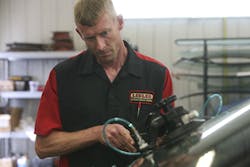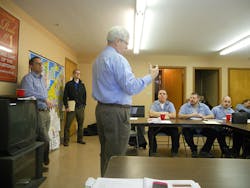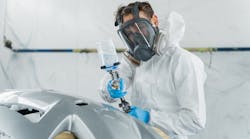How often do you see the following scenario at your shop?
A vehicle with a big hit is towed in. After your estimator performs a damage analysis, she determines your shop can’t do the work. Maybe the vehicle has damaged structural parts that can only be replaced by a shop in a repair network. Perhaps it qualifies as a total loss. Or it could be a brand-new luxury model or other vehicle you simply don’t have the expertise, tools or training to fix.
In any case, you’re watching money leave your business. Most often, shops look at these losses as simply part of the business. What they can’t make on a vehicle being removed from their shop they hope to make up with other business. The truth, however, is that every lost business opportunity can be transformed into a potential win if you plan for it. Use these five steps to build revenue where once you only saw defeat.
Step 1. Offer memorable customer service to everyone, all the time. If you think that once a prospective repair is towed out of your shop you’ve gained nothing, Randy Drury, owner of Full Service Auto Stop in Houston, says to think again. “You actually gained the most important think any business can collect—information,” he says. That information starts with an owner’s name and home address and possibly a phone number and email address.
From there, says Drury, shops can still go to work through education and guidance. “Our shop has email and snail mail templates that tell customers we lost, ‘Sorry we couldn’t be your repairer today, but we still want to help,’” he explains. “We attach a ‘customer bill of rights’ like a lot of shops post on their websites, along with other information on what to expect during a repair. And we ask that they remember us in the future.” If the customer is on-site, service reps pass out copies of the same information and wish customers well while trying to alleviate their fears with helpful guidance.
This may seem like a lot of effort for a client you’re losing, but Drury says shops need to keep in mind that most collision repair customers are genuinely frightened and concerned when seeking service. The greater the number of friendly industry faces and positive efforts they see the better.
“We don’t know what a customer will face when dealing with another shop, but we wish the best for them,” he says. “The keys here is to offer folks a genuinely positive experience in the midst of a stressful event—and one they’ll remember should they need help another time.”
But does it work? Drury says “absolutely.” He points to shop records that show customers from lost repairs coming returning for other services. He also says he has plenty of examples of customers pointing to a family member or friend who previously crossed paths with his business.
“Offering great customer service should be part of every shop’s routine, and it’s one of the most inexpensive services at your shop,” Drury says. “Use it to turn every customer encounter into a business opportunity. Plus, it’s also just the decent thing to do.”
Step 2: Swap services.
If a vehicle is being moved to another shop, there’s still a chance — though slight — you may be able to grab a piece of the repair pie. “Do you offer any specialized repairs, like airbag or glass replacement or something like spray-on bedliners?” says industry consultant Ben Bailey. “If the shop that gets the work needs any of those, don’t hesitate to reach out to them.” Bailey admits that this strategy may not reap rewards often, but it’s worth a try.
If your business, like half of all collision repair shops, offers mechanical services you may be in an even better position to grab some work. Bailey notes that most shops already have trusted businesses they sublet work to. “But they may be in the market for a new partner,” he says. Bailey says repairers should regularly try to learn about and work with each other for several reasons.
One, there’s currently plenty of work to go around, so shops shouldn’t feel they’re in a dog-eat-dog environment. Two, businesses that perform collision repairs typically are going to have a keener sense of what insurers and customers expect than other sublet businesses. Three, repairers have much to gain by working together. “You need to step outside your own workplace if you want learn,” says xxx. “Sometimes, gaining some valuable knowledge can be more important than what you’d make off of a single repair.”
Step 3: Salvage solutions.
These days, you probably say goodbye to most of your lost work because of total loss declarations. But you can turn some of these situations around if you’re willing to spend a little extra time with a customer, says Drury. He notes that if a vehicle crosses the total loss threshold by no more than $500-$800, shops can take a couple of steps to effectively diminish those numbers.
“If you can locate a good salvage part — maybe several— that you, the customer and the insurer trust, you can really trim those numbers down. Shipping times can slow down the repair times, which is going to raise the cost of a rental vehicle, but you may be able to negotiate with the customer and insurer to share some of those costs,” he explains.
Shops also can ask customers to pitch in more money for the repair to bring costs under the total loss threshold. Drury says the that money may be far less than what a customer would have to put down to purchase a replacement vehicle. It too may be a significant savings over what a customer would pay on a new, more expensive car payment. Many customers are more willing to stick with a car they know and invest some money to keep it than roll the dice on a replacement, Drury adds.
If those options won’t work and customers have to say “so long” to a once reliable member of the family, be prepared to offer them another solution — a recommendation to a dealer you trust. As noted earlier, customers need all the friends and solutions they can get following an accident. If you can point them to several dealers that will work with them to budget in a replacement vehicle, you’ve done the customer and the dealer a great favor.
Drury says this course offers one extra benefit — it paves the way to some potential business opportunities with dealers who may need a reliable repairer they can recommend to their customers. They possibly could need a shop to take care of dents, scratches, other repairs or high-quality detailing services. Partnerships like this help everyone involved.
Step 4. Keep records.
How much business did you lose last year and why? “If you can’t answer that question, then you can’t address this problem or plan for a workable solution,” says Bailey. He notes that most shops pay little mind to lost work, but this can be a big problem if they want to stay in business a long time. “Two lost repairs a month can mean $14,000 being sent down the road. That’s almost $170,000 a year,” says Bailey. “Money like that can buy a lot of new equipment, improvements and training or can be put away for other investments.”
“In a time when shops really need to think about raising their repair abilities to cope with more advanced vehicles, revenue like that is critical,” he adds.
Bailey advises shops to keep a running total of estimates for lost work, along with the reason a vehicle had to leave. Then, repairers need to examine this data during shop meetings and yearly planning.
Step 5. Take action
From there, shops must take a cold, hard look at why they’re losing work now and what factors or trends could cost them business in the near future. Along with totals, Bailey says shops should be looking at the growing need to become certified with one or more repair networks: “This becomes a more serious issue with each year. If shops can’t prove to insurers and customers they’re capable of performing a high-quality, safe repair on a vehicle, they’re not going to get work.”
OEMs are doing their part to grow these networks as much as possible. Selling a repairable vehicle is central to their business, which has always been the driving force behind networks. Consultant Mike Anderson recently pointed to OEM efforts to guide more vehicles into certified shops — most notably with GM’s ability to leverage its OnStar service to recommend customers use specific shops.
In fact, OnStar looks to be a key component of GM’s new repair network that starts up in 2018. GM has stated that once it has certified its first network shops, it plans to place them in OnStar’s shop locator service, along with performance scores for each calculated using network’s KPIs. Higher scores mean a shop has done a better job adhering to network procedures, which could make those shops better attractive in the eyes of a consumer.
“The bottom line is that shops are going to have to raise their training and equipment standards if they truly want to get the work at their doors into their operations,” says Bailey. “Right now, that’s the single best way to ensure your shop gets to repair every fixable car it sees or at least make the most out of every repair opportunity.”
Couple this effort with the steps listed here, and you’ll have a solid plan that can transform what once would have been a loss into some kind of gain — almost all of the time.
An old saying declares, “Good business is where you find it.” That’s just part of the story. Good business also is where you make it. Now might be a good time for you to make your move and reclaim lost opportunities.




